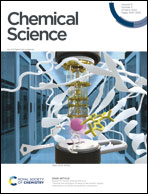Effect of pore diameter and length on electrochemical CO2 reduction reaction at nanoporous gold catalysts†
Abstract
In this work, we employ differential electrochemical mass spectrometry (DEMS) to track the real-time evolution of CO at nanoporous gold (NpAu) catalysts with varying pore parameters (diameter and length) during the electrochemical CO2 reduction reaction (CO2RR). We show that due to the increase in the local pH with increasing catalyst roughness, NpAu catalysts suppress the bicarbonate-mediated hydrogen evolution reaction (HER) compared to a flat Au electrode. Additionally, the geometric current density for CO2RR increases with the roughness of NpAu catalysts, which we attribute to the increased availability of active sites at NpAu catalysts. Together, the enhancement of CO2RR and the suppression of competing HER results in a drastic increase in the faradaic selectivity for CO2RR with increasing pore length and decreasing pore diameter, reaching near 100% faradaic efficiency for CO in the most extreme case. Interestingly, unlike the geometric current density, the specific current density for CO2RR has a more complicated relation with the roughness of the NpAu catalysts. We show that this is due to the presence of ohmic drop effects along the length of the porous channels. These ohmic drop effects render the pores partially electrocatalytically inactive and hence, they play an important role in tuning the CO2RR activity on nanoporous catalysts.



 Please wait while we load your content...
Please wait while we load your content...